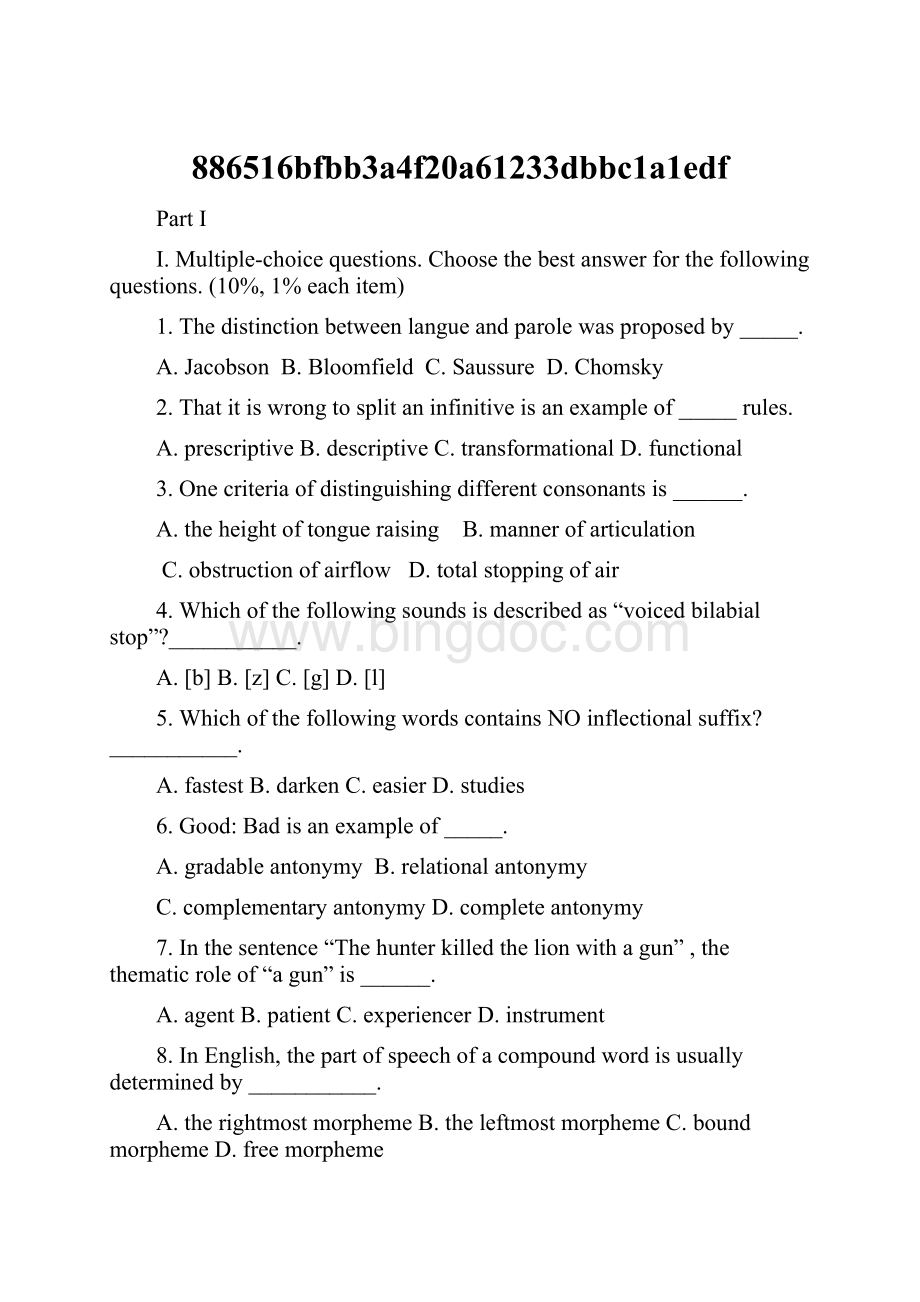886516bfbb3a4f20a61233dbbc1a1edf.docx
《886516bfbb3a4f20a61233dbbc1a1edf.docx》由会员分享,可在线阅读,更多相关《886516bfbb3a4f20a61233dbbc1a1edf.docx(12页珍藏版)》请在冰点文库上搜索。

886516bfbb3a4f20a61233dbbc1a1edf
PartI
I.Multiple-choicequestions.Choosethebestanswerforthefollowingquestions.(10%,1%eachitem)
1.Thedistinctionbetweenlangueandparolewasproposedby_____.
A.JacobsonB.BloomfieldC.SaussureD.Chomsky
2.Thatitiswrongtosplitaninfinitiveisanexampleof_____rules.
A.prescriptiveB.descriptiveC.transformationalD.functional
3.Onecriteriaofdistinguishingdifferentconsonantsis______.
A.theheightoftongueraisingB.mannerofarticulation
C.obstructionofairflowD.totalstoppingofair
4.Whichofthefollowingsoundsisdescribedas“voicedbilabialstop”?
___________.
A.[b]B.[z]C.[g]D.[l]
5.WhichofthefollowingwordscontainsNOinflectionalsuffix?
___________.
A.fastestB.darkenC.easierD.studies
6.Good:
Badisanexampleof_____.
A.gradableantonymyB.relationalantonymy
C.complementaryantonymyD.completeantonymy
7.Inthesentence“Thehunterkilledthelionwithagun”,thethematicroleof“agun”is______.
A.agentB.patientC.experiencerD.instrument
8.InEnglish,thepartofspeechofacompoundwordisusuallydeterminedby___________.
A.therightmostmorphemeB.theleftmostmorphemeC.boundmorphemeD.freemorpheme
9.Intermsoftheplaceofarticulation,thesounds[t],[s]and[n]sharethefeatureof________.
A.palatalB.alveolarC.bilabialD.dental
10.Theabsenceofawordinaparticularplaceinasemanticfieldofalanguageiscalled_______.
A.aphasiaB.lexicalgapC.speecherrorD.semanticfield
II.TrueorFalsequestions.DecidewhetherthefollowingstatementsareTrueorFalse.(10%,1%eachitem)
()1.AComprehensiveGrammaroftheEnglishLanguagebyQuirketal.isasynchronicstudyoflanguage.
()2.Theword“in”isanopenclassword.
()3. Chineseisatonelanguage.
()4.Theword“above”includes2syllables,inwhichthesound[b]isthecodaofthefirstsyllable.
()5.Thesemanticrelationshipbetweenthetwosentences“John’ssonisanengineer”and“Johnhasason”ispresupposition.
()6.Asyllableshouldcontainatleastonevowel.
()7.Comparedwithitsantonymsmall,thewordbigisamarkeditem.
()8.Thesentence“I’llbeback.”isadirective.
()9.Thesentence“Boysareboys”violatesthequantitymaxim.
()10.OgdenandRichardsproposedthesemantictriangle,arguingthattherelationbetweenawordandathingitreferstoisnotdirect,butmediatedbyconcept.
III.Fillintheblankswithproperterms.(20%,2%eachitem)
1.__________isthestudyofmeaninginuseorincontext.
2.Thestandardizedandinternationallyacceptedsystemforphonetictranscriptionis___________.
3.Intermsofsemanticrelationship,flowerisa(n)________oflily.
4.Intermsofgrammaticalcase,heisa(n)____________caseinthesentence“Hekilledalion.”
5.Thebranchofphoneticsthatstudiessoundsfromthespeaker’spointofviewislabeled_______phonetics.
6.Insecondlanguageacquisition,________referstoerrorssointernalizedthatnoamountofcorrectioncanundo.
7.Thehypothesisthatanimals,includinghumans,aregeneticallyprogrammedtoacquirecertainkindsofknowledgeandskillatspecifictimesinlifeiscalled________.
8.Theareaofthebrainthatisresponsibleforthecomprehensionofwordsandforselectionofwordswhenproducinglanguageis________.
9.Thehypothesisthatclaimsthatlanguageshapesthewaywethinkanddetermineswhatwecanthinkaboutiscalled_______.
10.Languageexistsintimeandchangesthroughtime.Thedescriptionofalanguageatsomepointoftimeiscalleda________studyoflanguage.
IV.Definition.Definefollowingterms.(20%,5%eachitem)
1.MaximalOnsetPrinciple
2.McGurkeffect
3.InputHypothesis
4.Aphasia
V.Questions.Answerthefollowingquestions.(40%,20%eachitem)
1.Discussyourunderstandingaboutpartofspeech.
2.Drawtreestructurestorepresentthewords“unlockable”,“reusable”and“unusable”,andexplaintheirmeanings.
PartII
I.Multiple-choicequestions.Choosethebestanswerforthefollowingquestions.(10%,1%eachitem)
1.______isformedbyanarrowingoftheairpassageatsomepointsothattheairinescapingmakesakindofhissingsound.
A.AplosiveB.AfricativeC.AnaffricateD.glide
2.Thevowel[i:
]in[fi:
d]isa______vowel.
A.closefrontunroundedB.closebackunrounded
C.openfrontroundedD.closebackrounded
3.______coversthestudyoflanguageuseinrelationtocontext,andinparticularthestudyoflinguisticcommunication.
A.SematicsB.PragmaticsC.SociolinguisticsD.Stylistics
4.Thefactthatabilitytospeakalanguageistransmittedfromgenerationtogenerationbyaprocessoflearning,andnotgeneticallyisusuallyreferredtoas______.
A.performanceB.languageacquisition
C.culturaltransmissionD.competence
5.Ofallthespeechorgans,the_____is/arethemostflexible.
A.mouthB.lipsC.tongueD.vocalcords
6.______isdefinedasanyregionallyorsociallydefinablehumangroupidentifiedbysharedlinguisticsystem.
A.AspeechcommunityB.Arace
C.AsocietyD.Acountry
7.______madethedistinctionbetweenlangueandparole.
A.ChormskyB.SaussureC.SapirD.Hall
8.Morphemessuchas“-er”,“-en”,“dis-”andsofortharecalled______morphemes.
A.inflectionalB.derivationalC.freeD.bound
9.Transformationalrulesdonotchangethebasic______ofsentences.
A.formB.structureC.soundpatternD.meaning
10.______arewrittenidenticallybutsounddifferently.
A.HomographsB.Homohphones
C.HomonymsD.Synonyms
II.TrueorFalsequestions.DecidewhetherthefollowingstatementsareTrueorFalse.(10%,1%eachitem)
()1.Morphologyandsyntaxstudythesameaspectoflanguage.
()2.Phoneticsdealswithhowsoundsareputtogetherandusedtoconveymeaning.
()3.Modernlinguisticsismostlydescriptive,butsometimesprescriptive.
()4.TheclassificationofEnglishconsonantsinvolvesbothmannerofarticulationandplaceofarticulation.
()5.Sometimesboundmorphemescanbeusedbythemselves.
()6.Languageisonlylinearly-structured.
()7.Meaningiscentraltothestudyofcommunication.
()8.Pragmaticsisrelatedtoandalsodifferentfromsemantics.
()9.Sociolinguisticsstudieslanguageinsocialcontexts.
()10.Asynchronicstudyoflanguageisahistoricalstudy.
III.Fillintheblankswithproperterms.(20%,2%eachitem)
1.______dealswithhowlanguageisacquired,understoodandproduced.
2.Theconsonant[f]canbedescribedas____________.\
3.Themorphemesthatcannotbeusedbythemselves,butmustbecombinedwithothermorphemestoformwordsarecalled_______morphemes
4.Twowordsthatare“opposite”inmeaningarecalled______.
5._________isthesmallestmeaningfulunitoflanguage.
6.ModernEnglishhasamuchweakercasemarkingsystem.Itssentenceshavetofollowabasicorderof______.
7.Applicationofthetransformationalrulesyields______structure.
8.Hyponymyistherelationshipwhichobtainsbetweenspecificandgenerallexicalitems.Thewordthatismoregeneralinmeaningiscalled_______.
9.whilethemeaningofasentenceisdecontextualized,thatofan_________iscontext-dependent.
10.Inmakingconversation,thegeneralprinciplethatallparticipantsareexpectedtoobserveiscalledthe_______________principleproposedbyGrice.
IV.Definition.Definefollowingterms.(20%,5%eachitem)
1.consonant:
2.linguafranca
3.diachroniclinguistics
4.pidgin
V.Questions.Answerthefollowingquestions.(40%,20%eachquestion)
1.Whatisthemaximofquality?
Illustratehowspeakersmayfloutthismaximtoconstructanimplicature.
2.Explain“synonymy”,“antonymy”,“polysemy,”and“hyponymy”withexamples.
PartIII
I.Multiple-choicequestions.Choosethebestanswerforthefollowingquestions.(10%,1%eachitem)
1.Thestatement“Doublenegationisincorrect.”isanexampleof_____rules.
A.prescriptiveB.descriptiveC.transformationalD.functional
2.Thedistinctionbetweenlinguisticcompetenceandperformancewasproposedby_____.
A.JacobsonB.BloomfieldC.D.H.HymesD.Chomsky
3.Consonantsandvowelsaredistinguishedby______.
A.placeofarticulationB.mannerofarticulation
C.obstructionofairflowD.totalstoppingofair
4.Whichofthefollowingsoundsisdescribedas“voicedalveolarstop”?
A.[d]B.[z]C.[g]D.[l]
5.WhichofthefollowingmorphemesISaboundmorpheme?
A.nessB.kissC.lossD.boss
6.WhichofthefollowingwordscontainsNOinflectionalsuffix?
A.fastestB.chaosC.easierD.studies
7.Dead:
aliveisapairof_____.
A.gradableantonymyB.converseantonymy
C.complementaryantonymyD.completeantonymy
8.Therelationshipofhyponymyisbetweenthemoregeneraltermsuchascolorandthemorespecificinstancesofitsuchasred,blueandwhite.Thegeneraltermcoloriscalledthe________.
A.hyponymB.superordinateC.co-hyponymsD.synonym
9.Inthesentence“Thehunterkilledthelion.”thesemanticroleof“thehunter”is______.
A.agentB.patientC.experiencerD.instrument
10.Hallidaydistinguishedthreesocialvariablesthatdeterminetheregister._________isnotoneofthem.
A.fieldofdiscourseB.tenorofdiscourse
C.modeofdiscourseD.ruleofdiscourse
II.TrueorFalsequestions.DecidewhetherthefollowingstatementsareTrueorFalse.(10%,1%eachitem)
()1.Historicallinguisticsisadiachronicstudyoflanguage.
()2.Intheantonympairold:
young,oldisthemarkeditem.
()3.“Ank”isamorpheme,becauseitappearsindifferentwords,suchastank,bank,rank.